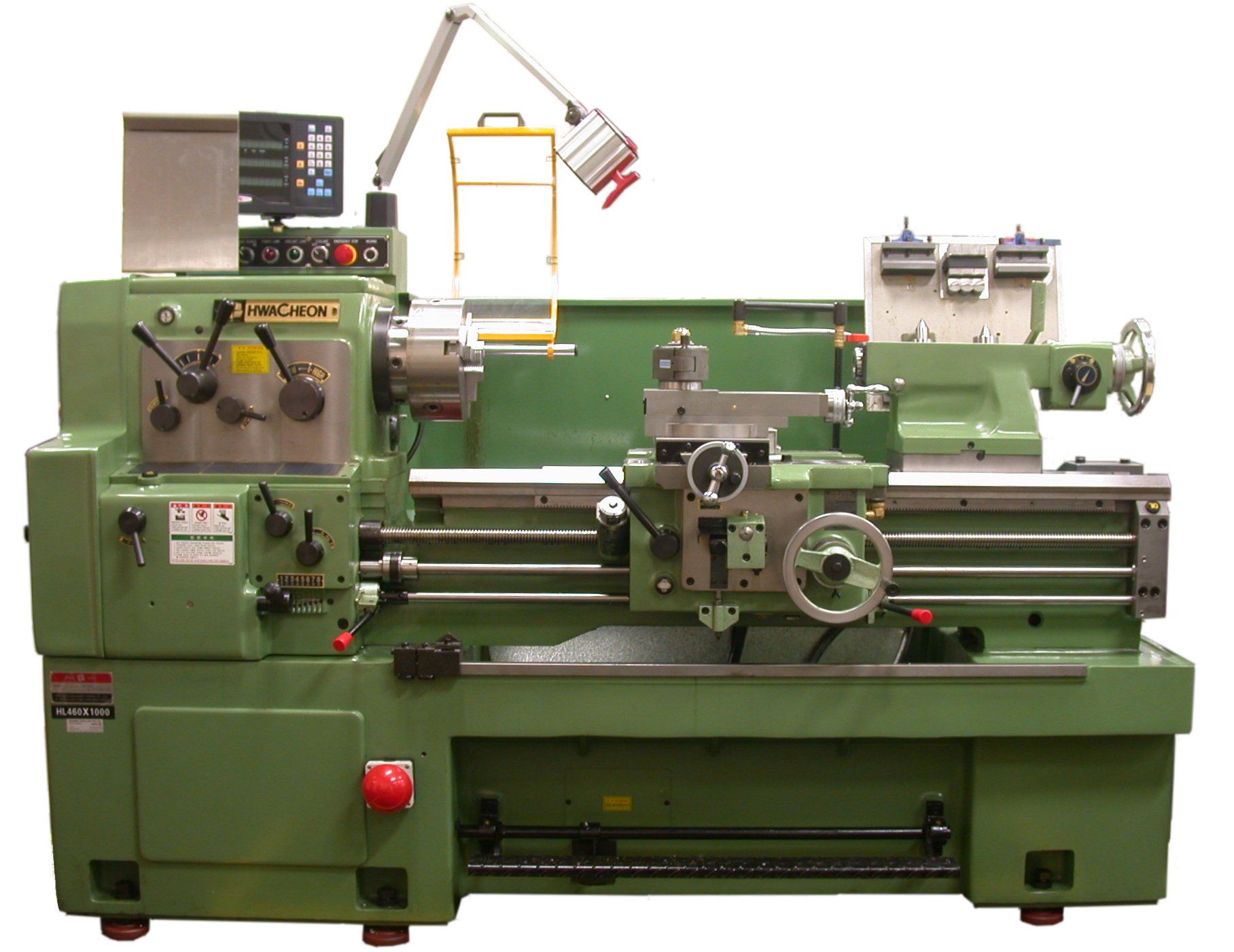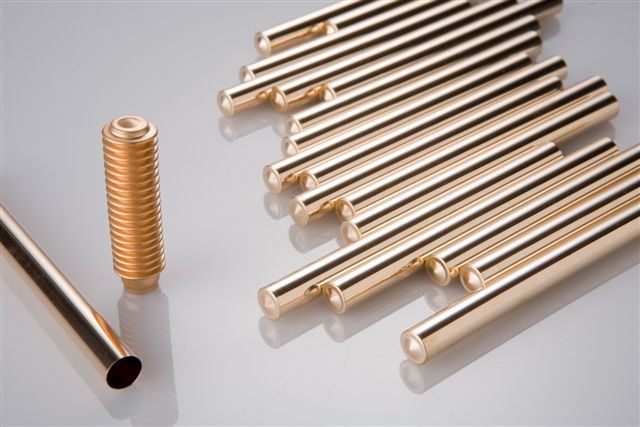|
Shear Forming
Shear forming, also referred as shear spinning, is similar to metal spinning. In shear spinning the area of the final piece is approximately equal to that of the flat sheet metal blank. The wall thickness is maintained by controlling the gap between the roller and the mandrel. In shear forming a reduction of the wall thickness occurs. Before the 1950s, spinning was performed on a simple turning lathe. When new technologies were introduced to the field of metal spinning and powered dedicated spinning machines were available, shear forming started its development in Sweden. Schematics Figure 2 shows the schematics of a shear forming process. 1. A sheet metal blank is placed between the mandrel and the chuck of the spinning machine. The mandrel has the interior shape of the desired final component. 2. A roller makes the sheet metal wrap the mandrel so that it takes its shape. As can be seen, s1 which is the initial wall thickness of the workpiece is reduced to s0. Workpie ... [...More Info...] [...Related Items...] OR: [Wikipedia] [Google] [Baidu] |
Metal Spinning
Metal spinning, also known as spin forming or spinning or metal turning most commonly, is a metalworking process by which a disc or tube of metal is rotated at high speed and formed into an axially symmetric part. Spinning can be performed by hand or by a CNC lathe. The metal spinning trade is one that dates back to antiquity and was a skill used in the Ancient Egyptian era. This is when metal spinning was limited to soft metals spun by human power on primitive lathes. The technique gave significant advances to hydro and steam power in Europe and North America in the 19th century and by the early 20th century the electric motor provided the necessary power and high-speed turning capability. With this advancement, metal spinning craftsmen were now able to spin higher quality pieces made out of brass, copper, aluminum and even stainless and cold-rolled steel. Metal spinning does not involve removal of material, as in conventional wood or metal turning, but forming (moulding) of s ... [...More Info...] [...Related Items...] OR: [Wikipedia] [Google] [Baidu] |
Lathe
A lathe () is a machine tool that rotates a workpiece about an axis of rotation to perform various operations such as cutting, sanding, knurling, drilling, deformation, facing, threading and turning, with tools that are applied to the workpiece to create an object with symmetry about that axis. Lathes are used in woodturning, metalworking, metal spinning, thermal spraying, reclamation, and glass-working. Lathes can be used to shape pottery, the best-known design being the Potter's wheel. Most suitably equipped metalworking lathes can also be used to produce most solids of revolution, plane surfaces and screw threads or helices. Ornamental lathes can produce three-dimensional solids of incredible complexity. The workpiece is usually held in place by either one or two ''centers'', at least one of which can typically be moved horizontally to accommodate varying workpiece lengths. Other work-holding methods include clamping the work about the axis of rotation using a ... [...More Info...] [...Related Items...] OR: [Wikipedia] [Google] [Baidu] |
Tensile Strength
Ultimate tensile strength (also called UTS, tensile strength, TS, ultimate strength or F_\text in notation) is the maximum stress that a material can withstand while being stretched or pulled before breaking. In brittle materials, the ultimate tensile strength is close to the yield point, whereas in ductile materials, the ultimate tensile strength can be higher. The ultimate tensile strength is usually found by performing a tensile test and recording the engineering stress versus strain. The highest point of the stress–strain curve is the ultimate tensile strength and has units of stress. The equivalent point for the case of compression, instead of tension, is called the compressive strength. Tensile strengths are rarely of any consequence in the design of ductile members, but they are important with brittle members. They are tabulated for common materials such as alloys, composite materials, ceramics, plastics, and wood. Definition The ultimate tensile strength ... [...More Info...] [...Related Items...] OR: [Wikipedia] [Google] [Baidu] |
Ductility
Ductility refers to the ability of a material to sustain significant plastic Deformation (engineering), deformation before fracture. Plastic deformation is the permanent distortion of a material under applied stress, as opposed to elastic deformation, which is reversible upon removing the stress. Ductility is a critical mechanical performance indicator, particularly in applications that require materials to bend, stretch, or deform in other ways without breaking. The extent of ductility can be quantitatively assessed using the percent elongation at break, given by the equation: \% \mathrm= \left ( \frac \right )\times100 where l_ is the length of the material after fracture and l_0 is the original length before testing. This formula helps in quantifying how much a material can stretch under tensile stress before failure, providing key insights into its ductile behavior. Ductility is an important consideration in engineering and manufacturing. It defines a material's suitabil ... [...More Info...] [...Related Items...] OR: [Wikipedia] [Google] [Baidu] |
Deep Drawing
Deep drawing is a sheet metal forming process in which a sheet metal blank is radially drawn into a forming die by the mechanical action of a punch. It is thus a shape transformation process with material retention. The process is considered "deep" drawing when the depth of the drawn part exceeds its diameter. This is achieved by redrawing the part through a series of dies. The flange region (sheet metal in the die shoulder area) experiences a radial drawing stress and a tangential compressive stress due to the material retention property. These compressive stresses ( hoop stresses) result in flange wrinkles (wrinkles of the first order). Wrinkles can be prevented by using a blank holder, the function of which is to facilitate controlled material flow into the die radius. Deep drawing presses, especially in the Aerospace and Medical industries, require unparalleled accuracy and precision. Sheet hydroforming presses do complex draw work. Bed size, tonnage, stroke, speed, and more ... [...More Info...] [...Related Items...] OR: [Wikipedia] [Google] [Baidu] |
Ironing (metalworking)
Ironing is a sheet metal forming process that uniformly thins the workpiece in a specific area. This is not to be mistaken with fabric Ironing. This process involves using force to evenly flatten a piece of sheet metal into a uniform shape. This could also be the root of the process name, as it uses pressure to flatten the material much like fabric Ironing. Process For the process, the piece of metal is placed against a tool that presses it forward, called a "Punch". the punch pushes the metal through a Die (manufacturing), Die, or more commonly 2 Dies, which are designed to push against the metal until it reaches a desired flatness. This also results in the piece being made longer, as the process spreads the metal out more rather than removing any of it. Ironing is commonly used alongside the process of Deep drawing, as the process of deep drawing is very similar in how it uses pressure, and deep drawing can often lead to irregularities in uniformity. Described briefly, deep ... [...More Info...] [...Related Items...] OR: [Wikipedia] [Google] [Baidu] |
Cold Work
In metallurgy, cold forming or cold working is any metalworking process in which metal is shaped below its recrystallization temperature, usually at the ambient temperature at or near room temperature. Such processes are contrasted with hot working techniques like Rolling (metalworking)#Hot rolling, hot rolling, forging, welding, etc. The same or similar terms are used in glassmaking for the equivalents; for example cut glass is made by "cold work", cutting or grinding a formed object. Cold forming techniques are usually classified into four major groups: squeezing, bending, drawing, and shearing. They generally have the advantage of being simpler to carry out than hot working techniques. Unlike hot working, cold working causes the crystallite, crystal grains and inclusions to distort following the flow of the metal; which may cause work hardening and anisotropic material properties. Work hardening makes the metal hardness, harder, stiffness, stiffer, and strength of materia ... [...More Info...] [...Related Items...] OR: [Wikipedia] [Google] [Baidu] |
Mechanical Properties
A material property is an intensive property of a material, i.e., a physical property or chemical property that does not depend on the amount of the material. These quantitative properties may be used as a metric by which the benefits of one material versus another can be compared, thereby aiding in materials selection. A property having a fixed value for a given material or substance is called material constant or constant of matter. (Material constants should not be confused with physical constants, that have a universal character.) A material property may also be a function of one or more independent variables, such as temperature. Materials properties often vary to some degree according to the direction in the material in which they are measured, a condition referred to as anisotropy. Materials properties that relate to different physical phenomena often behave linearly (or approximately so) in a given operating range . Modeling them as linear functions can significantly si ... [...More Info...] [...Related Items...] OR: [Wikipedia] [Google] [Baidu] |




